For nearly ten years, I have used and strongly endorsed Rowenta irons. They’re heavy, which is a good thing when you’re sewing and seeking to press rather than iron. They have a steel sole plate, which heats quickly and evenly for good results on the fabric. And they have a solid steam function that really shoots steam into your projects.
But in the past two or three years, Rowenta has really been leaving me cold, if you’ll pardon the pun. The issue: leaks. Oh, the LEAKS!! I have absolutely had it with my leaking iron. That water is HOT, y’all, so not only is it splashing and sputtering all over my project when it’s on the ironing board, but it’s dropping on my feet and scalding me. My feet! Unacceptable.
So a couple weeks ago, I’d finally had enough and decided to put the suggestions I’ve received to the test. Instead of getting another Rowenta to replace my leaky iron, or even another brand of iron, I upgraded to the gravity feed iron, in hopes that I’d never have to carry a pitcher of water from my kitchen to refill my reservoir ever again.
Today, then, in the ring: the Rowenta versus the Gravity Feed Iron.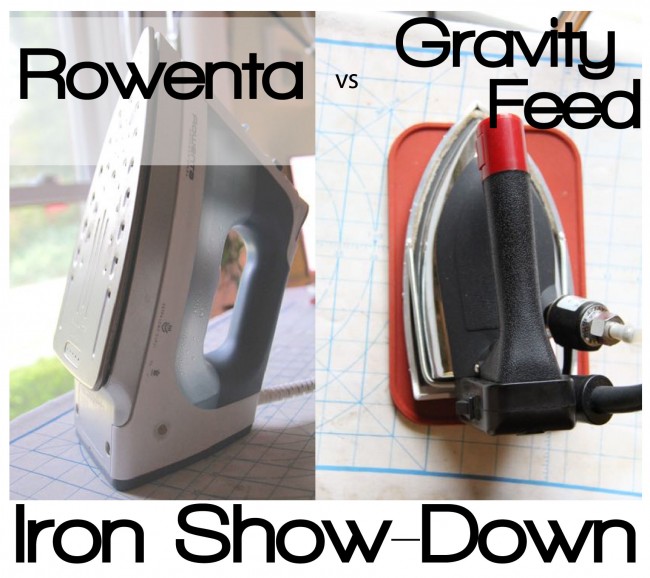
I have told my students for years, and wrote in Stitch By Stitch: sewing is 90% cutting and 60% ironing, so it’s basically -50% stitching. Your stitching can be your weakest skill and you can still get good results if you cut well and press often. As Kenneth King says, you can save bad sewing with good ironing, and ruin good sewing with bad ironing. So a good iron is very, very high on my sewing supplies list. I have happily used the best home-sewing iron I could find (the Rowenta), but this leak issue is the pits, and I’m not the only one complaining. In an IG conversation, tons of friends complained, including Liesl Gibson, that their Rowentas leak–and Alexia Abegg chimed in and highly recommended a gravity feed iron as a solution.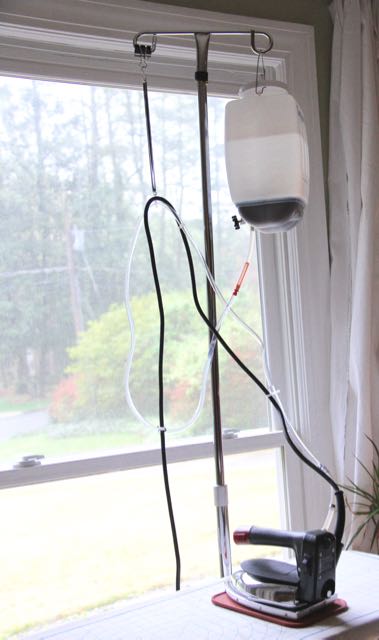 A gravity feed iron is what it sounds like: an iron that relies on gravity to carry the water from the reservoir to the steam chamber of the iron. Your standard household iron, also called a steam-generator iron, has a reservoir inside the iron body, and steam is made immediately prior to being used on the fabric; the gravity feed iron carries water as needed from a two-gallon container through a series of tubing and super-heats it before your trigger releases it into the sewing.
A gravity feed iron is what it sounds like: an iron that relies on gravity to carry the water from the reservoir to the steam chamber of the iron. Your standard household iron, also called a steam-generator iron, has a reservoir inside the iron body, and steam is made immediately prior to being used on the fabric; the gravity feed iron carries water as needed from a two-gallon container through a series of tubing and super-heats it before your trigger releases it into the sewing.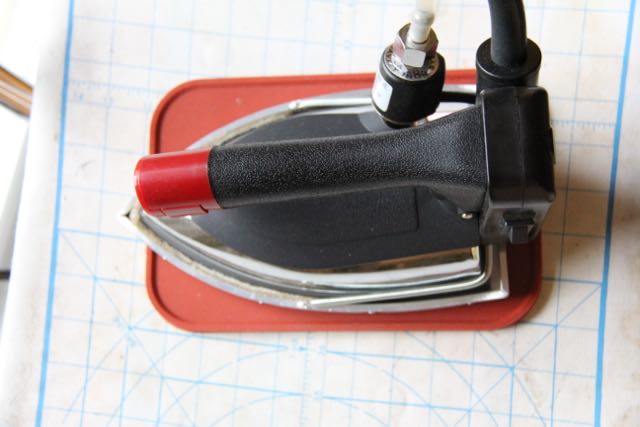 A review over on Threads Magazine points out that gravity feed irons are heavier–most are around 4 pounds–which does a good deal of the work for you. And this article from Fashion Incubator points out that getting steam into your fabric is essential to get good results–although much of the article focuses on industrial irons for manufacturing, which isn’t want I’m looking to do, the information is really fascinating in a nerdy way. Getting steam back out matters, too, which is why the article discusses commercial equipment; I don’t need anything nearly of that magnitude, but I do need an iron that will avoid leaving giant spots of water on my fabric which require time to dry before the fibers are really set into their new shape. (See this article for pointers on properly ironing finished garments!)
A review over on Threads Magazine points out that gravity feed irons are heavier–most are around 4 pounds–which does a good deal of the work for you. And this article from Fashion Incubator points out that getting steam into your fabric is essential to get good results–although much of the article focuses on industrial irons for manufacturing, which isn’t want I’m looking to do, the information is really fascinating in a nerdy way. Getting steam back out matters, too, which is why the article discusses commercial equipment; I don’t need anything nearly of that magnitude, but I do need an iron that will avoid leaving giant spots of water on my fabric which require time to dry before the fibers are really set into their new shape. (See this article for pointers on properly ironing finished garments!)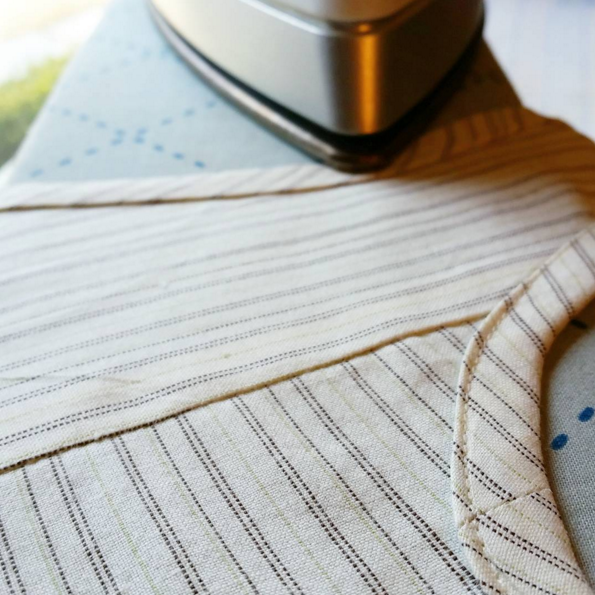 Because that’s what ironing is–or in the case of sewing, pressing. We are shaping the fabric into what we want it to be in our finished garment (check out this PDF from the University of Kentucky Extension Service for LOADS of details on best practices for pressing in home sewing). And in order to do that, we have to soften the fibers of which the fabric is made, using steam. Getting steam into the fabric fast is the best way–way better than spraying with water and then heating with the iron, asking the heat to create the steam AFTER the water moistens the fabric. So, when choosing an iron, we want one that will make the most steam in the least amount of time, and then deliver it right where we want it on the project. Commercial presses use all kinds of vacuums and blowers and things to get the steam back out, but at the volume that I’m sewing, that’s not the issue I face–I am more concerned with getting steam IN but not wetting the fabric, because wet fabric is weaker and the shape isn’t set until the fabric is fully dry.
Because that’s what ironing is–or in the case of sewing, pressing. We are shaping the fabric into what we want it to be in our finished garment (check out this PDF from the University of Kentucky Extension Service for LOADS of details on best practices for pressing in home sewing). And in order to do that, we have to soften the fibers of which the fabric is made, using steam. Getting steam into the fabric fast is the best way–way better than spraying with water and then heating with the iron, asking the heat to create the steam AFTER the water moistens the fabric. So, when choosing an iron, we want one that will make the most steam in the least amount of time, and then deliver it right where we want it on the project. Commercial presses use all kinds of vacuums and blowers and things to get the steam back out, but at the volume that I’m sewing, that’s not the issue I face–I am more concerned with getting steam IN but not wetting the fabric, because wet fabric is weaker and the shape isn’t set until the fabric is fully dry.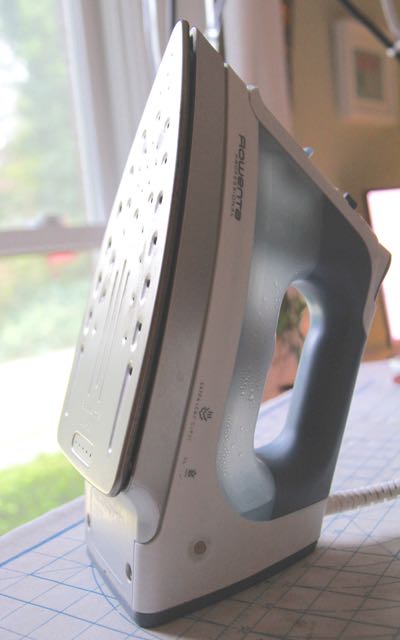 With a home iron, like my Rowenta, the steam is generated inside the body of the iron and then applied to the fabric. I’ve always liked the Rowenta because it’s heavy for a home iron, much more so than the little “hotel room” irons you’ll see at the big box stores, so we’re already using gravity to our advantage. I also like that most Rowentas have a fairly large reservoir, which decreases the amount of time I’m walking back and forth to fill the iron, or worse, ironing with no steam and wondering why I’m not getting better results.
With a home iron, like my Rowenta, the steam is generated inside the body of the iron and then applied to the fabric. I’ve always liked the Rowenta because it’s heavy for a home iron, much more so than the little “hotel room” irons you’ll see at the big box stores, so we’re already using gravity to our advantage. I also like that most Rowentas have a fairly large reservoir, which decreases the amount of time I’m walking back and forth to fill the iron, or worse, ironing with no steam and wondering why I’m not getting better results.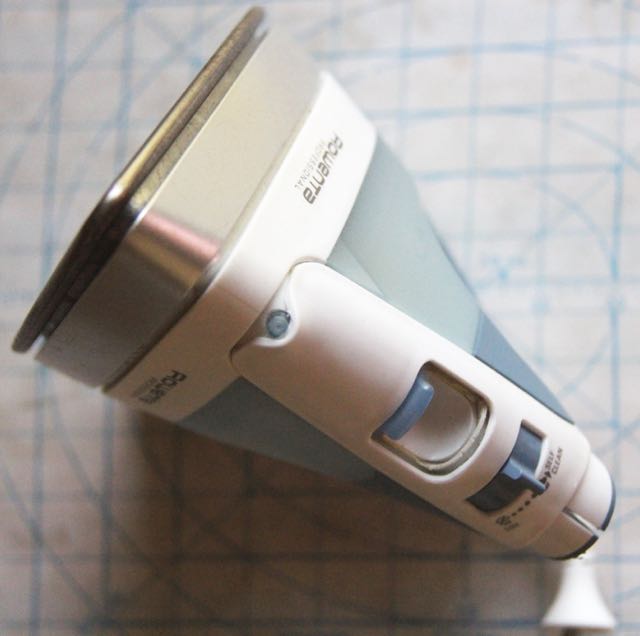 Quite honestly, this is a good enough iron that were it not for the leak issue, I wouldn’t be looking for a replacement. It has steam holes but not too many–I’m not worried about how much steam so much as getting it in the right places quickly–and a stainless steel sole plate–Teflon-coated plates can scratch and send dangerous particles into the air, and are designed to keep the plate from sticking when using heavy starch, which I don’t do frequently enough to make it relevant to me.
Quite honestly, this is a good enough iron that were it not for the leak issue, I wouldn’t be looking for a replacement. It has steam holes but not too many–I’m not worried about how much steam so much as getting it in the right places quickly–and a stainless steel sole plate–Teflon-coated plates can scratch and send dangerous particles into the air, and are designed to keep the plate from sticking when using heavy starch, which I don’t do frequently enough to make it relevant to me.
But the leaking is absolutely unacceptable–bordering on unconscionable. The water should stay IN THE IRON, not pour out onto the ironing board, as in this photo from Instagram: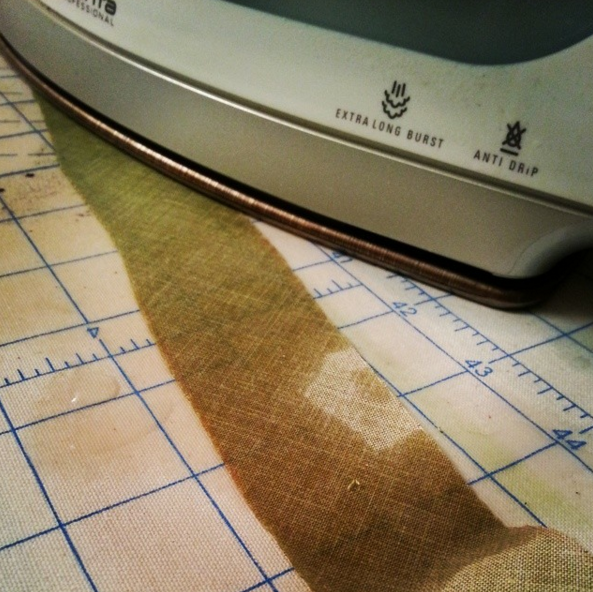 See how wet my bias tape is? If I’m working with fabric that’s extra stretchy anyway, and then make it wet, which makes it weaker but doesn’t set the shape, ugh. Not cool, Rowenta.
See how wet my bias tape is? If I’m working with fabric that’s extra stretchy anyway, and then make it wet, which makes it weaker but doesn’t set the shape, ugh. Not cool, Rowenta.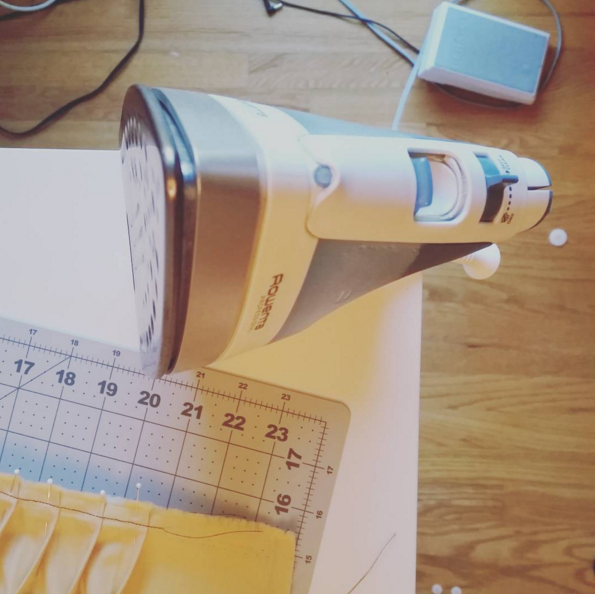 This iron is somewhere between 3 and 5 years old, and has been leaking (according to my IG feed) for at least 3 of those years. The water escapes as bubbling scalding drips along the seam between the body of the iron and the sole plate. I’ve heard rumors of people repairing these with some heat-resistant industrial glue along the line where the leak occurs, but I was looking for a more permanent solution, one that was reliable.
This iron is somewhere between 3 and 5 years old, and has been leaking (according to my IG feed) for at least 3 of those years. The water escapes as bubbling scalding drips along the seam between the body of the iron and the sole plate. I’ve heard rumors of people repairing these with some heat-resistant industrial glue along the line where the leak occurs, but I was looking for a more permanent solution, one that was reliable.![]() When I looked into the gravity feed, I was concerned that it would be prohibitively expensive. I learned that it was almost exactly the same cost as another Rowenta, maybe a little less depending on the model of Rowenta I selected. I still had some of the same concerns as Peter over at Male Pattern Boldness, namely that this style of iron seems to take up a lot of space and how do I even know that it’s going to last as long? There are totally models that are more expensive than the one I was looking at–the Sapporo–such as the Naomoto, which comes very highly regarded. Was I making a mistake by considering a less-expensive model, and was this just a more cumbersome version of the Rowenta I already wanted to replace?
When I looked into the gravity feed, I was concerned that it would be prohibitively expensive. I learned that it was almost exactly the same cost as another Rowenta, maybe a little less depending on the model of Rowenta I selected. I still had some of the same concerns as Peter over at Male Pattern Boldness, namely that this style of iron seems to take up a lot of space and how do I even know that it’s going to last as long? There are totally models that are more expensive than the one I was looking at–the Sapporo–such as the Naomoto, which comes very highly regarded. Was I making a mistake by considering a less-expensive model, and was this just a more cumbersome version of the Rowenta I already wanted to replace?
I sprang for it. At right around $100, and considering I own no fewer than SIX irons that have all quit on me and each cost close to or more than that much, I figured gambling on this one was certainly no more risky than getting another iron like the ones I already have and seeing a leak appear in that one, too. Along with the Sapporo, and using the “others who bought this item also purchased” feature on Amazon, I ordered an IV-pole to hold the 2+ gallon reservoir, and the filter substrate that’s required to keep the water clean when passing through the iron (and to preventing voiding the warranty).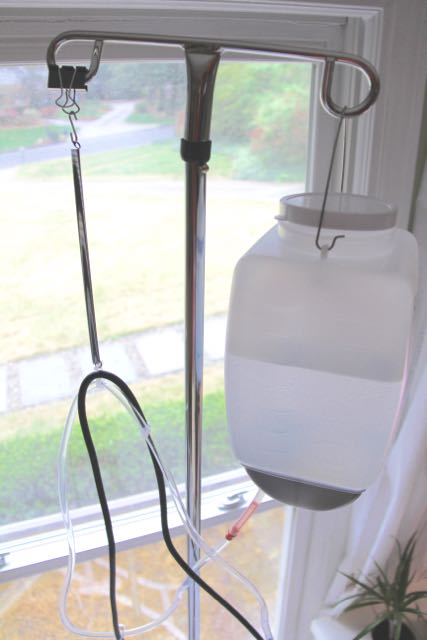 It is, perhaps, not beautiful. My eldest came in the room and asked, “Uh, what, are you doing surgery in here??” But since I am working in our dining room (where I do most of my sewing, as opposed to my studio space, where I shoot video but don’t really do much construction), and hope one day to move to the basement and have a dining table in the dining room, I was hesitant to plug a giant hook into the ceiling. It seems sooooo permanent.
It is, perhaps, not beautiful. My eldest came in the room and asked, “Uh, what, are you doing surgery in here??” But since I am working in our dining room (where I do most of my sewing, as opposed to my studio space, where I shoot video but don’t really do much construction), and hope one day to move to the basement and have a dining table in the dining room, I was hesitant to plug a giant hook into the ceiling. It seems sooooo permanent.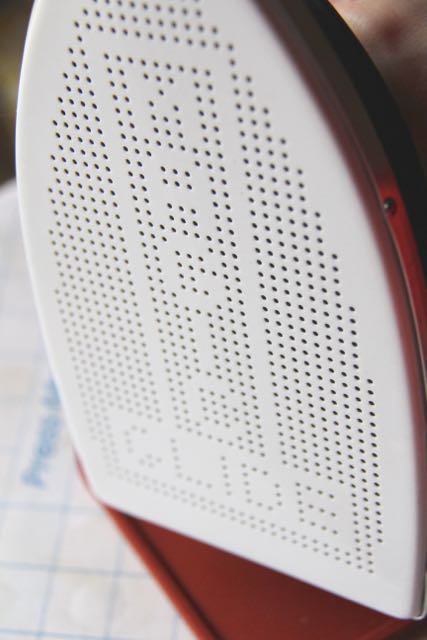 The Sapporo came with a Teflon sole-plate–not one spray-coated, but actually molded of Teflon. It glides crazy smoothly, and means that no matter what fiber I’m working with, I don’t scorch my fabric, even when the iron has been on for hours, which it often is. It heats up SUPER quickly, stays VERY hot, and has a small face, all of which are huge pluses. In fact, that last–that it has a smaller profile and footprint–is way more impactful than I would have suspected, and makes an enormous difference in pressing pleats, gathers, waistbands, and details. The weight of the iron plus the speed with which I get high-heat steam means that I do way fewer passes over garments to get superior results over the Rowenta.
The Sapporo came with a Teflon sole-plate–not one spray-coated, but actually molded of Teflon. It glides crazy smoothly, and means that no matter what fiber I’m working with, I don’t scorch my fabric, even when the iron has been on for hours, which it often is. It heats up SUPER quickly, stays VERY hot, and has a small face, all of which are huge pluses. In fact, that last–that it has a smaller profile and footprint–is way more impactful than I would have suspected, and makes an enormous difference in pressing pleats, gathers, waistbands, and details. The weight of the iron plus the speed with which I get high-heat steam means that I do way fewer passes over garments to get superior results over the Rowenta.
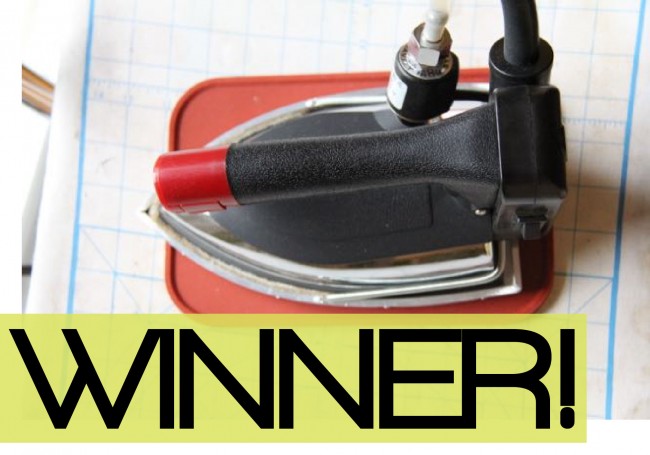 After a week of working with this iron on cottons, linens, seersucker, bias tape, hems, necklines, sleeves, cuffs, and linings, I can honestly say that my feelings for this iron border on unnatural. I would hold hands with it if it didn’t get so hot. I want to be BFFs with it forever, and would escalate our friendship to More Than Friends were I not already very happily married. There are no leaks, no scorching, no drips and flawless results. It takes less time and less effort to get better results than ever with my old iron, and all for about the same expense. This is vastly less portable–you can never really take this iron anywhere with you outside your home–but since I rarely travel anywhere that I need an iron, and have a (decent but cheap) iron at the studio, portability isn’t really an issue for me.
After a week of working with this iron on cottons, linens, seersucker, bias tape, hems, necklines, sleeves, cuffs, and linings, I can honestly say that my feelings for this iron border on unnatural. I would hold hands with it if it didn’t get so hot. I want to be BFFs with it forever, and would escalate our friendship to More Than Friends were I not already very happily married. There are no leaks, no scorching, no drips and flawless results. It takes less time and less effort to get better results than ever with my old iron, and all for about the same expense. This is vastly less portable–you can never really take this iron anywhere with you outside your home–but since I rarely travel anywhere that I need an iron, and have a (decent but cheap) iron at the studio, portability isn’t really an issue for me.
Am I saying that everyone should run out and get a gravity feed? Not even remotely. I use my iron every single day for hours at a time–anyone who isn’t sewing at that volume really doesn’t need to take up the space that a gravity feed requires. But if you’re doing a lot of sewing, have a place to keep this where it won’t be an eyesore or need to be dismantle and stored each time you sew, and were planning to spend in the $100 range on a new iron anyway, then I can’t recommend it highly enough. The improvement over what I was using before is night and day.
What iron are you using? Are you happy? I’d love to hear about your experiences and compare them to my own!


Martha Myers
March 28, 2016 at 7:13 pmLike you, I often sew for hours each day. I’ve tried both types of irons you describe here. I have one of those hooks in my sewing room ceiling. Right now I’m happy with my ordinary Rowenta though I had to clean it with vinegar a few months ago and now I use filtered water only.
Two draw-backs to the gravity feed iron: Be careful of your elbow. Lots of people have developed tennis elbow after using a gravity feed. It is heavier and the wear on your arm can surprise you. One solution is to lower your board a few inches. Just a suggestion.
The other draw-back is that I like to re-arrange my sewing space from time to time. Drilling that hook into the ceiling makes that more difficult. A small thing though.
My last gravity feed stopped delivering water from the reservoir to the iron after about 2 years. Husband and I tried cleaning everything out to no avail. I will probably buy another one when my Rowenta dies.
Bottom line: All irons fail after a few years. At least that has been my experience.
Accacia Mullen
March 28, 2016 at 11:00 pmI use a gravity feed iron now. It was a gift a couple years ago, meant to replace a standard (Walmart purchase, I think) iron that didn’t stand up to my use after a couple years. My biggest beef with that iron was that it had an automatic shut-off “feature.” After 15 minutes or so, it turned off. As most sewists know, that’s not long enough to finish a project. The other trouble is that we have hard water, which wreaked havoc on the insides. I did clean it with vinegar, but once we pronounced it “dead” (I think the steam button stopped working), my husband and I took it apart. I was appalled by how much scaly deposit was in that iron.
Needless to say I only use distilled water in the gravity feed iron and will always use the pellets recommended. I like the weight of the iron. I like the heat, though it doesn’t seem as hot as I thought it would be. My teflon plate may diffuse the heat a bit.
Sometimes I wish there were more of a point at the tip, or that it were more portable, but all in all, I’m very happy with this iron.
Jean C.
March 29, 2016 at 9:03 amFunny thing about irons; I mean we could go all the way back to when our grandmothers/great grand mothers used flat irons that they set on a stove to heat… but who wants to do that! Although, no leaks! Through all these years of ironing… I’ve used an iron or 5 or more!!! I used to iron for people in my home. (what was I thinking!!!!) Soooo , needless to say I went thru a ton of irons! Burning them up because well when you have an iron on for as long as you do while’st ironing tons of clothes… they get hot and after a while. Pweff! Plus like you said; I’ve had a lot of irons leak on my projects/clothing. I’ve been thru Black and Decker irons, galore!!!! Sending them back when they started to leak etc… they were more than willing to replace them. I have had and still have Rowenta irons…. I’m going to step up to bat for Rowenta! Through the years I have made/altered/ refitted so many wedding dresses and tons of others dresses/pants/quilts etc… and thus done a lot of pressing. After going thru one Rowenta iron…. I thought; hmmmm maybe I should check out the instructions!!! In the instructions for my 2nd Rowenta I came across an instruction that said… low and behold use distilled water (which of course I have used for years!), (minerals have a tendency to counteract the heating unit in an iron)…Sooo the more I thought about it I thought even with distilled water leaving water in an iron all of the time has got to cause corrosion, so #1 I no longer leave water in the iron after I am done for the day. Also I have found that for some reason… distilled water mixed half/half with my tap water works wonders. Go figure; we have hard water and in the past if I used straight tap of course it was way too much for the iron. (This was when I started ironing for people… way back in the 80’s) Ever since I have used distilled and tap water and empty them when I’m through for the day/night; irons usually last about 8-10 years. Unless I drop them…. which of course… is rather hard on them! Lol…
Ruth
March 29, 2016 at 11:24 amWe have had a regular Oster steam iron for the last 10 years. We have bottles of rain water that we refill and rotate (as the heavens allow) for use in its reservoir. Tap water killed many irons before we got wise to what was happening. Additionally, we no longer leave water in the iron when it’s out of use.
Whenever it kicks the bucket, I’d certainly check out a gravity feed… just for the sake of not having to kill my pressing ‘flow’ to refill the reservoir ever so often.
Kim
March 29, 2016 at 9:56 pmAll these years I thought I was doing something wrong to make my (many) Rowentas leak. When I sent one especially expensive model back to be repaired, after it leaked upon arrival, the customer service rep acted like I was trying to make them do a warranty repair on an iron I had run over with my car twice and filled with maple syrup. I had to yell at her to make her stop questioning me! So after all this time, it turns out the iron I love (when it works) really and truly is a defective brand. Thank you for sharing your research. As soon as my 3 month old Rowenta starts leaking (ok, ok, it’s already leaking; it started leaking after 2 months, I’m not kidding) I’ll be looking in to a gravity feed iron like yours.
Why isn’t Rowenta doing something about this? If it’s a known problem
throughout the stitching community, isn’t Rowenta embarrassed?
Agnes
March 30, 2016 at 12:39 pmI used to use a teflon plate iron but with all the scorching issues when using wonder under, I switched to an iron with a stainless plate that was much easier to clean. I just bought a basic black and decker with a retractable cord – it’s on the heavy/wide side but it’s been over a year and I haven’t had any leaking or burning issues. It takes a bit of time to heat up and does have auto-shut off which is inconvenient when sewing for a few hours. I’m glad I haven’t bought the Rowenta after reading this post! Had you ever considered an Oliso? That seems to be quite popular too.
Becky Thompson
April 3, 2016 at 8:47 amI’m using my iron as much as you are and after a post from Lladybird.com on a gravity feed iron, I took the plunge when I came across a deal at the 2015 Houston Quilt Show. I too was/am a Rowenta fan, (I just bought a new Focus 1725 from a cheap deal on Woot for $39) and you are right about the water spewing as being unconscionable – love that word btw. Since they all spew, the Rowenta weight is what kept me coming back. My gravity feed is the Sapporo SP-527 and I got it for $75 and lugged it back on the bus so no shipping. What’s a good word here? Adore maybe? All I know, is that it’s right up there with blood platelets IMO. I never considered the smaller size to be an advantage, but now that you mention it, it was so nice yesterday to be able to actually fit the iron inside a bag I was making to press out the wrinkles in the lining in the bottom of the bag. You cannot do that with anything other than the Rowenta travel iron (which I have too at our vacation house). Perhaps I’m living on the edge, but I haven’t bought the stuff to mix in the water for the gravity feed. We live in 15-grain hard water here in South Texas so I only use purchased distilled water in my irons. I agree with the other poster not to leave water standing in irons that are not in use, but that’s not an issue with the gravity feed. Now that I think of it, that’s probably what killed my Rowenta garment steamer. Hmm. Anyway, I got hubs to hang a strong hook in the ceiling but I’m hating the cumbersome cord and tubing that drags on the corner of my ironing board. I never thought of an IV pole! Ingenious! What model do you have that can hold two gallons of water without tipping over?
Leanne
May 21, 2016 at 9:03 amThanks for this very thorough review. Thinking about replacing my Rowenta. I am also interested in knowing if you need a particular model iv pole that can hold two gallons of water without tipping over? Is this ever a problem for you? Thanks.
Deborah
May 23, 2016 at 9:42 amWhen I put the iron in my Amazon cart, they suggested one of those “others who bought this product also purchased” items, and that’s the IV pole I bought. I keep it at the maximum height and have never had any issues with instability at all!
Leanne
May 23, 2016 at 11:09 amThank you so much.